|
Laya
- Gasa : Not quite a hidden land
|
 |
Bhutan Tourism |
 |
Bhutan Information |
|
|
|
|
Laya-Gasa:
Layaps
|
 |
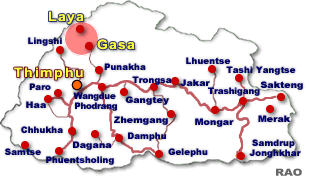 |
| A
decade ago, the semi-nomadic yak herders Layaps called their home be-yul,
the hidden land, where Shabdrung Ngawang Namgyal first entered Bhutan.
Sitting at 3,800m above sea level on the lap of the 7,100m Masagang, one
of Bhutan's 20 spectacular peaks, Laya had little contacts beyond its confines,
some of the only exposure being an occasional sponsored trip to Thimphu
by a group of Layaps to partake in cultural shows. |
|
|
When
Laya opened to tourism in the early 80s, women and children gathered around
the "white guests" (tourists) and stared in awe.
A discarded canned food
tin caused a scramble. There was no school, no health units, no livestock
units.
Today
tourists are greeted by school children with: "Where are you from? What
is your name? " in English. |
|
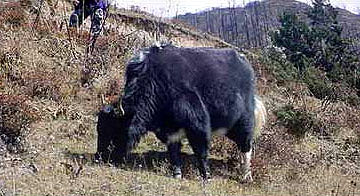 |
Today Laya boasts a wireless telephone, a basic
health unit (BHU), a livestock unit, two non-formal education centres,
a renewable natural resources centre, a Jigme Dorji national park branch
office and four shops. Solar panels are used by more and more Layaps. The
number of yaks have increased manifold and mules and horses are a familiar
sight in Laya, they being the measure of wealth. Laya's gup Passang says
that about 90 percent of the geog's 140 households own either yaks or horses
or both. Government had also given number of yaks to the people as soelra.
top
| Layap's
lives have become much better |
 |
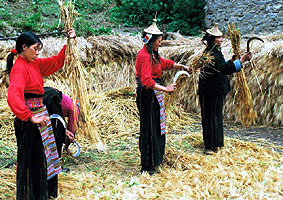 |
| Layap women harvesting |
| "Layap's
lives have become much better," said 49-year old Laya Tongra Damchoe who,
after a stint at the royal academy of performing arts in Thimphu in the
70s, returned home to tend to yaks. Damchoe said that in the old days rice
was carried on backs and took five days to reach Gasa from Punakha. "We
used to sleep in caves and under trees."
Ugyen
Tshering, 40, a veteran guide who has been trekking past Laya for years
believes that Laya's growth has galloped faster than Thimphu's. |
|
Before
houses were few and far between and most were in ruins with roofs fallen
apart, Ugyen said.
Today
there were many houses, colourfully painted and fitted with solar panels.
"During annual religious ceremony in Punakha, Layaps would gladly butcher
pigs for food and alcohol. They don't do that no more."
Lhaba
Tshering, 27, who studied till class nine in Gasa and who is now a non-formal
education teacher in his village said that the people of Punakha and Gasa
no longer called them "bjops". "They call us Layaps." The school also faces
the problem of dropouts and absentees. From the 106 students that had enrolled
in the beginning of the year about 16 had left by October. Teachers expect
30 more to leave with the onset of the migration season to the warmer valleys
of Punakha. Students leave because their parents want them to herd yaks.
Said Ap Pema Dorji, 51: "If our children go to higher education and later
when they get jobs in towns and settle there, who will look after the yaks,
do business and bring home rations?"
top
| Attitude
was changing |
 |
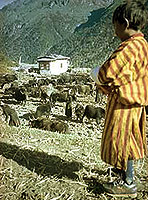 |
| A modern Layap boy surveys the recent yak show |
| The
students enjoy school and have dreams and ambitions. Eight-year old Kinley
Wangchuk of class II wants to be an engineer, Pema Wangchuk, 10, class
II, a pilot, and Passang Thinley, 8, class II, a teacher. Nine-year old
girl Tshering Gyem of class I likes studying English and wants to be a
doctor. They represent the hope and future of Laya. There is also the adult
non-formal education on practical subjects like agriculture, livestock
and cleanliness bringing a change in the mindset of the Layaps. About 90
percent of the adult learners are men who take care of business and are
considered the family providers. The women herd and milk the yak and do
almost all field works including collecting firewood. Men is dominant by
tradition. |
|
Only
about 30 percent of the students in Laya school are girls. Most young girls
tend to yaks in the high pasture land and are away for most of the year.
The
BHU manned nurse and health assistant provides immunization and care to
pregnant mothers besides other basic health services. Sometimes the BHU
staff go after yak herds for immunization follow up because a mother couldn't
come to the BHU due to her yaks. Today an increasing number of Layap mothers
come to deliver babies at the unit.
Gup
Passang said that Laya could do with more development like a wider mule
track especially from Gasa - a lifeline for the Layaps. "During winter
the narrow steep track is frozen with ice or covered with snow which makes
traveling extremely hazardous, and in the past yaks have fallen off the
track," Passang said.
top
| Layap
woman dress |
 |
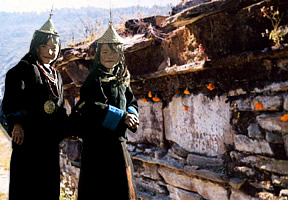 |
| Layap school girls |
| Progress
and development has brought about other inevitable changes as well. Except
for a few elders, the Layap men have long since abandoned the traditional
chari gho and shoe (yue-lham) for the conventional gho and socks and leather
shoes. Laya Tongra Damchoe said that the art of making yue-lham was forever
lost. Only the women still wear their traditional dress against a growing
preference for imported sweaters and shirts. The long over-jacket worn
over their kira had disappeared. |
|
"The craft of weaving and stitching traditional
clothes with wool, imported from Tibet, is
dying with the old people," said 32 year-old Lhakpa Tshering, Laya's former
chimi. To preserve the Layap woman dress, it has been made compulsory for
all girl students to wear their dress to the school.
Drinking
and now smoking is a problem in Laya according to health assistant, Sangay
Dorji. There are four shops in Laya and all sell cigarettes and imported
and national made liquor. The Layap's preferences have jumped from singchang
to whisky, the former being considered mild. Recently a drunk man slept
outside his house and froze to death. It's not uncommon to see a father
and a teenage son drinking together in bars. Assault cases are high.
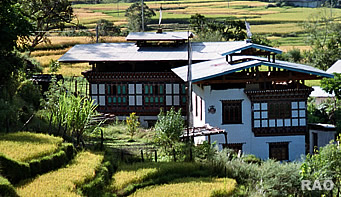 |
| Mo Chhu Valley, Punakha |
| The
practice of polyandry that ensured that property stayed within a family
is also waning. Layaps have begun to settle separately leading to land
fragmentation and increasing the pressure on limited grazing land.
By
December, a snow carpeted Laya is empty except a few old people. The Layaps
would have migrated to Punakha to return by March with their yearly supply
of rice and other essentials. |
|
As
more Layaps gain exposure and more children pass through the education
system their age-old routine is not as exciting as going to watch the "video"
which the rich neighbour's bought recently.
"Things
change, " said Ap Pema Dorji. "Whether it is good or bad, or simply change,
is difficult to say. Sometimes old things die out for new things to grow."
The
launching of the web page would promote communication, transparency and
further enhance effectiveness in delivering qualitative developmental activities
and also promote tourism, a dzongkhag official said.
The
web page also carries all necessary information about the dzongkhag located
in the extreme north west of the country bordered by Tibet. Of the dzongkhag's
four gewogs, Laya and Lunana, are located at an altitude of 3,800 to 4,200
meters. The people there lead a nomadic life compelling them to seasonally
migrate to higher places in summer and to the lower valleys of Punakha
and Wangdue in winter. These extremities posed formidable challenges to
the dzongkhag in delivering developmental activities and services, said
a dzongkhag official.
In
a recent development, Laya gewog was connected with a telephone facility.
With mountain passes over 5,000 meters, all telephone equipment were lifted
in a helicopter. There are also plans for these two gewogs to be connected
with e-service. Druknet of Bhutan Telecom helped the dzongkhag to launch
the web page.
|
| Contributed
by Kencho Wangdi, Kuensel, Bhutan's National
Newspaper |
top
| Information on Bhutan |
 |
| Links |
 |
 |
 |
External
links |
|








